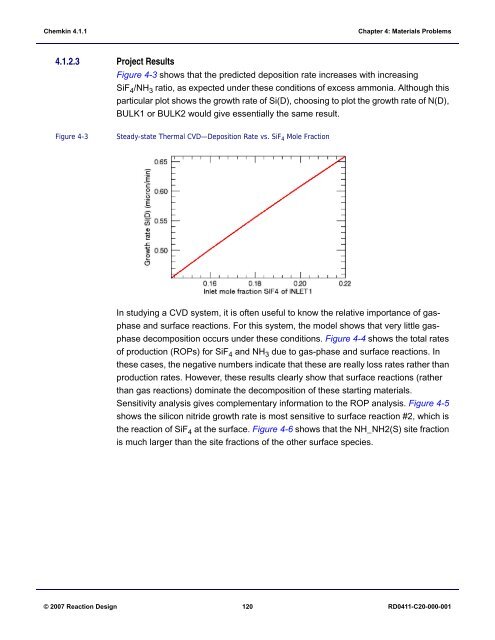Tutorials Manual
Tutorials Manual
Tutorials Manual
You also want an ePaper? Increase the reach of your titles
YUMPU automatically turns print PDFs into web optimized ePapers that Google loves.
Chemkin 4.1.1<br />
Chapter 4: Materials Problems<br />
4.1.2.3 Project Results<br />
Figure 4-3 shows that the predicted deposition rate increases with increasing<br />
SiF 4 /NH 3 ratio, as expected under these conditions of excess ammonia. Although this<br />
particular plot shows the growth rate of Si(D), choosing to plot the growth rate of N(D),<br />
BULK1 or BULK2 would give essentially the same result.<br />
Figure 4-3<br />
Steady-state Thermal CVD—Deposition Rate vs. SiF 4 Mole Fraction<br />
In studying a CVD system, it is often useful to know the relative importance of gasphase<br />
and surface reactions. For this system, the model shows that very little gasphase<br />
decomposition occurs under these conditions. Figure 4-4 shows the total rates<br />
of production (ROPs) for SiF 4 and NH 3 due to gas-phase and surface reactions. In<br />
these cases, the negative numbers indicate that these are really loss rates rather than<br />
production rates. However, these results clearly show that surface reactions (rather<br />
than gas reactions) dominate the decomposition of these starting materials.<br />
Sensitivity analysis gives complementary information to the ROP analysis. Figure 4-5<br />
shows the silicon nitride growth rate is most sensitive to surface reaction #2, which is<br />
the reaction of SiF 4 at the surface. Figure 4-6 shows that the NH_NH2(S) site fraction<br />
is much larger than the site fractions of the other surface species.<br />
© 2007 Reaction Design 120 RD0411-C20-000-001
















